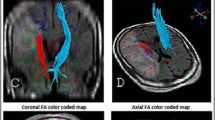Abstract
Diffusion tensor magnetic resonance (MR) imaging was used to evaluate motor functions in stroke patients. The aim of this study was to clarify whether imaging can be used to predict orthotic needs in patients with hemiplegia. We studied 25 patients (age range, 16–78 years) with intracerebral hemorrhages (putamen 15, thalamus 7, frontal subcortex 3). Diffusion tensor MR imaging was undertaken on admission at rehabilitation hospital for stroke patients. The fractional anisotropy (FA) value of the pyramidal tract was calculated. We compared the FA value in the ROI of the cerebral peduncle with the necessity for orthosis at discharge from the rehabilitation hospital. As a result, the FA values of the affected side in patients who needed orthosis at discharge were lower than those in patients who did not need orthosis. There was no significant difference in the FA values of the unaffected side. We concluded that the need for orthosis in patients with hemiplegia after stroke rehabilitation could be predicted using the diffusion tensor MR images of corticospinal tractography.





Similar content being viewed by others
References
Maeshima S, Truman G, Smith DS, Dohi N, Nakai K, Itakura T, Komai N (1997) Functional outcome following thalamic haemorrhage: relationship between motor and cognitive functions and ADL. Disabil Rehabil 19:459–464
Langhorne P, Bernhardt J, Kwakkel G (2011) Stroke rehabilitation. 377:1693–1702
Dorinson SM (1961) Rehabilitation after stroke. Emphasis on usefulness in restoration of function. Calif Med 94:310–314
Yamanaka T, Akashi K, Ishii M (2004) Stroke rehabilitation and long leg brace. Top Stroke Rehabil 11:6–8
Kakurai S, Akai M (1996) Clinical experiences with a convertible thermoplastic knee–ankle–foot orthosis for post stroke hemiplegic patients. Prosthet Orthot Int 20:191–194
Yamada K, Mori S, Nakamura H, Ito H, Kizu O, Shiga K, Yoshikawa K, Makino M, Yuen S, Kubota T, Tanaka O, Nishimura T (2003) Fiber tracking method reveals sensorimotor pathway involvement in stroke patient. Stroke 34:159–162
Mori S, van Zijl PC (2002) Fiber tracking: principles and strategies—a technical review. NMR Biomed 15:486–490
Miyai I, Sonoda S, Nagai S, Takayama Y, Inoue Y, Kakehi A, Kurihara M, Ishikawa M (2011) Results of new policies for inpatient rehabilitation coverage in Japan. Neurorehabil Neural Repair 25:540–547
Maeshima S, Ueyoshi A, Osawa A, Ishida K, Kunimoto K, Shimamoto Y, Matsumoto T, Yoshida M (2003) Mobility and muscle strength contralateral to hemiplegia from stroke: benefit from self-training with family support. Am J Phys Med Rehabil 82:456–462
Gotoh F, Terayama Y, Amano T (2001) Development of a novel, weighted, quantifiable stroke scale: Japan stroke scale. Stroke 32:1800–1807
Chino N (1997) Functional evaluation of stroke impairment assessment set (SIAS) and functional independence measure (FIM). Springer, Tokyo
Thomalla G, Glauche V, Weiller C, Röther J (2005) Time course of wallerian degeneration after ischaemic stroke revealed by diffusion tensor imaging. J Neurol Neurosurg Psychiatry 76:266–268
Konishi J, Yamada K, Kizu O, Ito H, Sugimura K, Yoshikawa K, Nakagawa M, Nishimura T (2005) MR tractography for the evaluation of functional recovery from lenticulostriate infarcts. Neurology 64:108–113
Kwon YH, Son SM, Lee J, Bai DS, Jang SH (2005) Combined study of transcranial magnetic stimulation and diffusion tensor tractography for prediction of motor outcome in patients with corona radiata infarct. J Rehabil Med 43:430–434
Kunimatsu A, Aoki S, Masutani Y, Abe O, Mori H, Ohtomo K (2003) Three dimensional white matter tractography by diffusion tensor imaging in ischemic stroke involving the corticospinal tract. Neuroradiology 45:532–535
Liu X, Tian W, Kolar B, Qiu X, Johnson MD, Ekholm S (2011) MR diffusion tensor and perfusion-weighted imaging in preoperative grading of supratentorial nonenhancing gliomas. Neuro-Oncology 13:447–455
Koyama T, Tsuji M, Miyake H, Ohmura T, Domen K (2011) Motor outcome for patients with acute intracerebral hemorrhage predicted using diffusion tensor imaging: an application of ordinal logistic modeling. J Stroke Cerebrovasc Dis. doi:10.1016/j.jstrokecerebrovasdis.2011.06.014
Kusano Y, Seguchi T, Horiuchi T, Kakizawa Y, Kobayashi T, Tanaka Y, Seguchi K, Hongo K (2009) Prediction of functional outcome in acute cerebral hemorrhage using diffusion tensor imaging at 3T: a prospective study. AJNR Am J Neuroradiol 30:1561–1565
Fujii S (1935) Hanshinfuzui no chiryouhou (Treatment for hemiplegia). Jikken Iho 21:1811–1826 (in Japanese)
Acknowledgments
We would like to express our deepest gratitude to the staff of the Rehabilitation Center at Hanno Seiwa Hospital who provided carefully considered feedback and valuable comments.
Author information
Authors and Affiliations
Corresponding author
Rights and permissions
About this article
Cite this article
Maeshima, S., Osawa, A., Nishio, D. et al. Diffusion tensor MR imaging of the pyramidal tract can predict the need for orthosis in hemiplegic patients with hemorrhagic stroke. Neurol Sci 34, 1765–1770 (2013). https://doi.org/10.1007/s10072-013-1330-z
Received:
Accepted:
Published:
Issue Date:
DOI: https://doi.org/10.1007/s10072-013-1330-z




